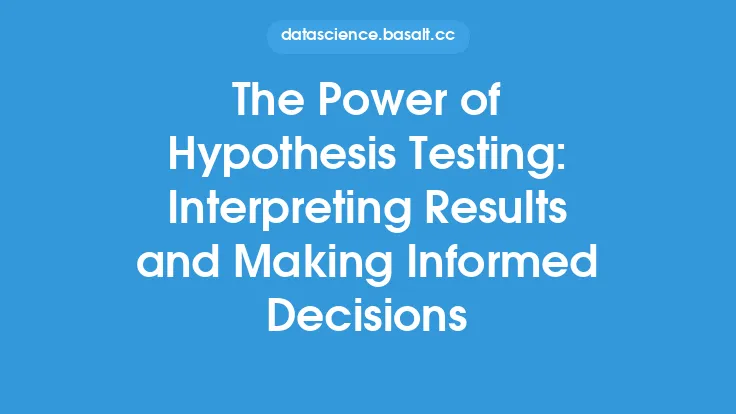When conducting hypothesis testing, interpreting the results is a crucial step that helps researchers and data analysts understand the implications of their findings. Hypothesis testing is a statistical technique used to make inferences about a population based on a sample of data. It involves formulating a null hypothesis and an alternative hypothesis, collecting data, and then using statistical methods to determine whether the null hypothesis can be rejected in favor of the alternative hypothesis. In this article, we will provide a step-by-step approach to interpreting results in hypothesis testing, covering the key concepts, statistical measures, and best practices.
Understanding the Null and Alternative Hypotheses
The first step in interpreting results in hypothesis testing is to understand the null and alternative hypotheses. The null hypothesis (H0) is a statement of no effect or no difference, while the alternative hypothesis (H1) is a statement of an effect or difference. For example, in a study examining the effect of a new medication on blood pressure, the null hypothesis might be "the new medication has no effect on blood pressure," while the alternative hypothesis might be "the new medication reduces blood pressure." The null hypothesis is often denoted as H0, while the alternative hypothesis is denoted as H1.
Calculating Test Statistics and P-Values
Once the null and alternative hypotheses are defined, the next step is to calculate the test statistic and p-value. The test statistic is a numerical value that summarizes the data and is used to determine whether the null hypothesis can be rejected. The p-value, on the other hand, is the probability of observing a test statistic at least as extreme as the one observed, assuming that the null hypothesis is true. The p-value is used to determine the significance of the results, with smaller p-values indicating stronger evidence against the null hypothesis. Common test statistics include the t-statistic, F-statistic, and chi-squared statistic, among others.
Interpreting P-Values and Test Statistics
Interpreting p-values and test statistics requires careful consideration of the research question, sample size, and level of significance. The level of significance, often denoted as alpha (α), is the maximum probability of rejecting the null hypothesis when it is true. Common levels of significance include 0.05 and 0.01. If the p-value is less than the level of significance, the null hypothesis can be rejected in favor of the alternative hypothesis. For example, if the p-value is 0.01 and the level of significance is 0.05, the null hypothesis can be rejected, indicating that the results are statistically significant. On the other hand, if the p-value is greater than the level of significance, the null hypothesis cannot be rejected, indicating that the results are not statistically significant.
Understanding Type I and Type II Errors
When interpreting results in hypothesis testing, it is essential to consider the risks of Type I and Type II errors. A Type I error occurs when the null hypothesis is rejected when it is true, while a Type II error occurs when the null hypothesis is not rejected when it is false. The probability of a Type I error is equal to the level of significance (α), while the probability of a Type II error is denoted as beta (β). The power of a test, which is the probability of rejecting the null hypothesis when it is false, is equal to 1 - β. Understanding Type I and Type II errors is crucial in hypothesis testing, as it helps researchers and data analysts to balance the risks of false positives and false negatives.
Considering Effect Size and Confidence Intervals
In addition to p-values and test statistics, effect size and confidence intervals are essential considerations in hypothesis testing. Effect size refers to the magnitude of the difference or relationship between variables, while confidence intervals provide a range of values within which the true population parameter is likely to lie. Effect size can be measured using metrics such as Cohen's d, which is the difference between the means of two groups divided by the standard deviation. Confidence intervals, on the other hand, can be constructed using the sample mean and standard error. For example, a 95% confidence interval for the population mean might be constructed as the sample mean ± 1.96 standard errors.
Best Practices for Interpreting Results
When interpreting results in hypothesis testing, several best practices should be followed. First, researchers and data analysts should clearly define the research question and hypotheses, ensuring that the null and alternative hypotheses are specific and testable. Second, the level of significance should be set a priori, and the p-value should be compared to this level to determine statistical significance. Third, effect size and confidence intervals should be reported in addition to p-values and test statistics, providing a more complete understanding of the results. Finally, the limitations of the study, including the risks of Type I and Type II errors, should be acknowledged and discussed.
Common Pitfalls and Misconceptions
Several common pitfalls and misconceptions can occur when interpreting results in hypothesis testing. One common pitfall is the failure to consider the research question and hypotheses, leading to a mismatch between the statistical test and the research question. Another pitfall is the misuse of p-values, including the failure to consider the level of significance and the risks of Type I and Type II errors. Additionally, the failure to report effect size and confidence intervals can lead to an incomplete understanding of the results. Finally, the misinterpretation of statistical significance as practical significance can lead to incorrect conclusions and decisions.
Conclusion
Interpreting results in hypothesis testing requires a careful and nuanced approach, considering the research question, hypotheses, test statistics, p-values, effect size, and confidence intervals. By following best practices and avoiding common pitfalls and misconceptions, researchers and data analysts can ensure that their conclusions are accurate and reliable. Ultimately, the goal of hypothesis testing is to make informed decisions and draw meaningful conclusions, and a thorough understanding of the results is essential to achieving this goal. By providing a step-by-step approach to interpreting results in hypothesis testing, this article aims to provide a comprehensive guide for researchers and data analysts, helping them to navigate the complexities of statistical inference and make informed decisions based on data.





